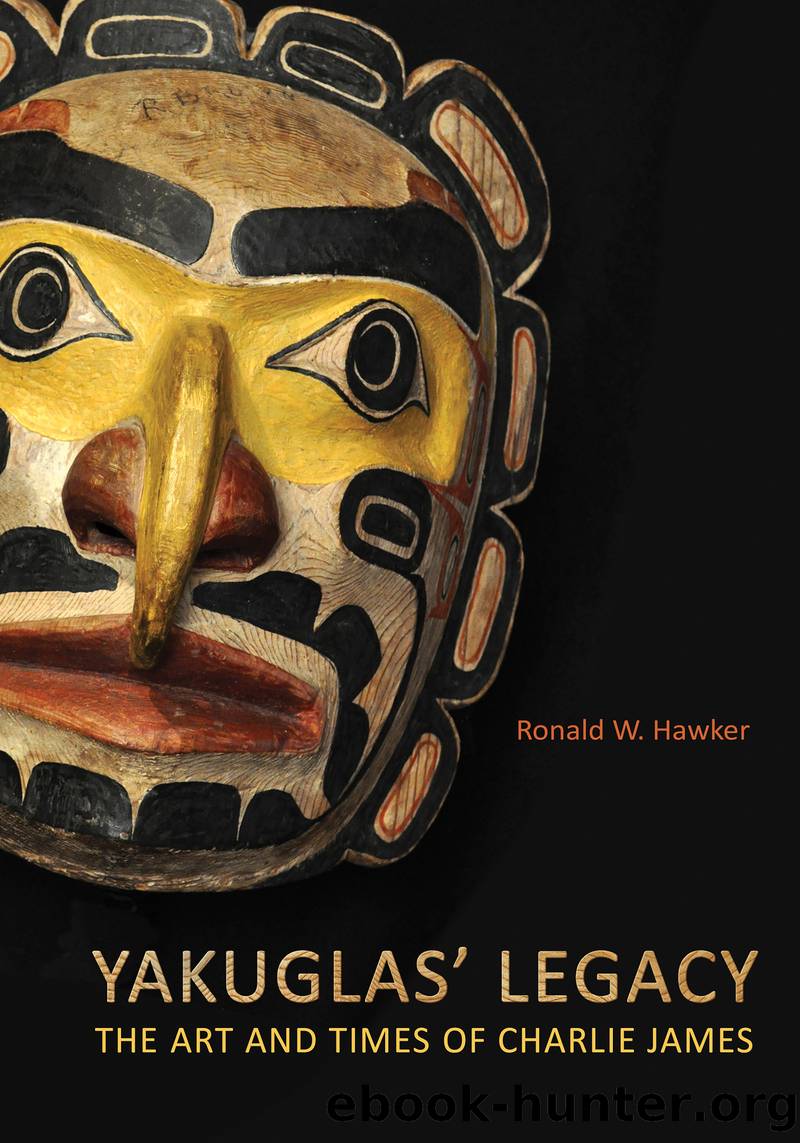Yakuglas' Legacy by Ronald W. Hawker

Author:Ronald W. Hawker
Language: eng
Format: epub
ISBN: 978-1-4426-2014-8
Publisher: University of Toronto Press
Published: 2017-01-01T16:00:00+00:00
According to museum provenance at UBCâs Museum of Anthropology, Peter Smith (Sewidanaquilla, also spelled Siwidânakwala) was a Tlawitsis chief and commissioned James to carve a pole (Figure 4.5) in 1907 at around the same time that a major feast dish attributed to James in the museumâs collection was created (Figures 3.19â20). Siwidânakwalaâs daughter was Sara Constance, better known as Abayaâa, and thus Siwidânakwala was also Mungo Martinâs father-in-law.40 However, family descendants counter that Peter Smith would have been too young to hold this name or to commission the pole at that time. The pole did stand in front of Chief Siwidiâs house, the Smith family house, but it had been commissioned by Chief Tom Siwid-Smith, Abayaâaâs father and Mungo Martinâs father-in-law, and was subsequently transferred to his son, Peter (also known as Adatsa).41
The location of the pole in Kalugwis between two flanking house posts indicates that it was erected in front of an old-style plank house, or gukwdzi,42 before the shingled Edwardian house for a nuclear family seen in the background was constructed. The Siwidânakwala pole has seven figures: from top to bottom, a qulos, a humanoid with the tail of the mink figure below him in his mouth, a killer whale with his tail between the teeth of the mink figure above him and his face in his blowhole, a second qulos, a bear, and a humanoid.
The mink43 appears as a hero living in Kalugwis in a Gwawaenuk story recorded by George Hunt.44 The Mamalilikulla people from Village Island have origin stories that connect to the sisiutl and an ancestral figure, the mink, Tâlisalagiâlakw, translated as âBorn to Be the Sun.â Tâlisalagiâlakw used the power of the sisiutl to defeat his enemies, the wolves,45 during myth time.46 A similar story occurs among the Kwakiutl as well.47 Killer whale48 is a common emissary in the stories of Komokwa and features in ancestral stories in which the protagonist receives a treasure from the chief of the Under-the-Sea world.49 The qulos figure would have had a specific name associated with the founding of the numaym â possibly, in this case, Odzistales.50 The two humanoid figures are clearly ancestral figures. The public celebration of ancestral histories in poles like this, with their specific references to ancestors and their interactions with the spirit and animal worlds linked to names, potlatch seats, and resource sites owned by the patron through his numaym position, were important politically in the context of tribal movements and the definition and limitation of chiefly authority, land, and resources under the Indian Act.
The commissioning of a crest pole and a monumental feast dish at the same time suggests that they were carved for a potlatch memorializing the erection of a new lineage house as part of a marriage ceremony, since the house and feast dishes were gifts brought by the bride and poles were sometimes inaugurated at a house opening.51 The year 1910 corresponds to the year given for Abayaâaâs first marriage, to David Hunt;52 this suggests that the pole might
Download
This site does not store any files on its server. We only index and link to content provided by other sites. Please contact the content providers to delete copyright contents if any and email us, we'll remove relevant links or contents immediately.
Blood and Oil by Bradley Hope(1531)
Wandering in Strange Lands by Morgan Jerkins(1374)
Ambition and Desire: The Dangerous Life of Josephine Bonaparte by Kate Williams(1346)
Daniel Holmes: A Memoir From Malta's Prison: From a cage, on a rock, in a puddle... by Daniel Holmes(1295)
It Was All a Lie by Stuart Stevens;(1265)
Twelve Caesars by Mary Beard(1258)
The First Conspiracy by Brad Meltzer & Josh Mensch(1140)
What Really Happened: The Death of Hitler by Robert J. Hutchinson(1131)
London in the Twentieth Century by Jerry White(1114)
Time of the Magicians by Wolfram Eilenberger(1089)
The Japanese by Christopher Harding(1086)
Twilight of the Gods by Ian W. Toll(1085)
Cleopatra by Alberto Angela(1063)
A Woman by Sibilla Aleramo(1054)
Lenin: A Biography by Robert Service(1046)
The Devil You Know by Charles M. Blow(987)
Reading for Life by Philip Davis(973)
The Life of William Faulkner by Carl Rollyson(925)
1965--The Most Revolutionary Year in Music by Andrew Grant Jackson(924)
